人教版(2019)选择性必修第一册Unit 4 Body Language Using Language 2 Reading for Writing课件(共27张)
文档属性
| 名称 | 人教版(2019)选择性必修第一册Unit 4 Body Language Using Language 2 Reading for Writing课件(共27张) | 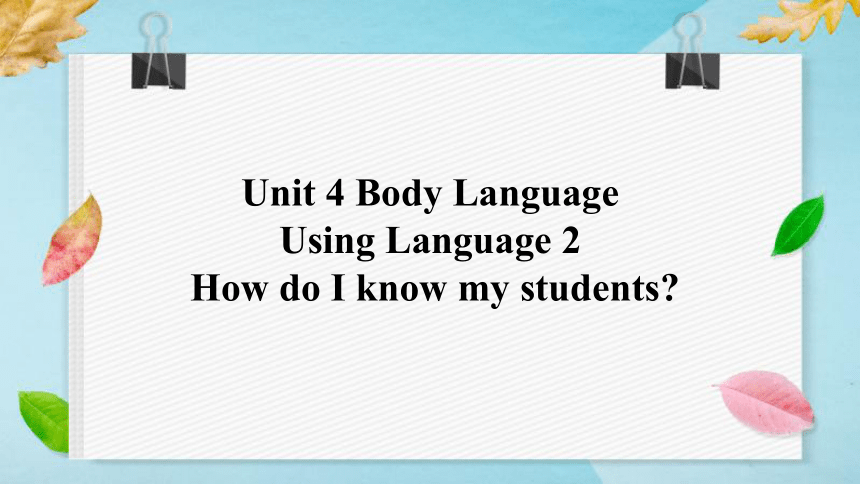 | |
| 格式 | pptx | ||
| 文件大小 | 26.5MB | ||
| 资源类型 | 教案 | ||
| 版本资源 | 人教版(2019) | ||
| 科目 | 英语 | ||
| 更新时间 | 2024-10-11 16:18:25 | ||
图片预览

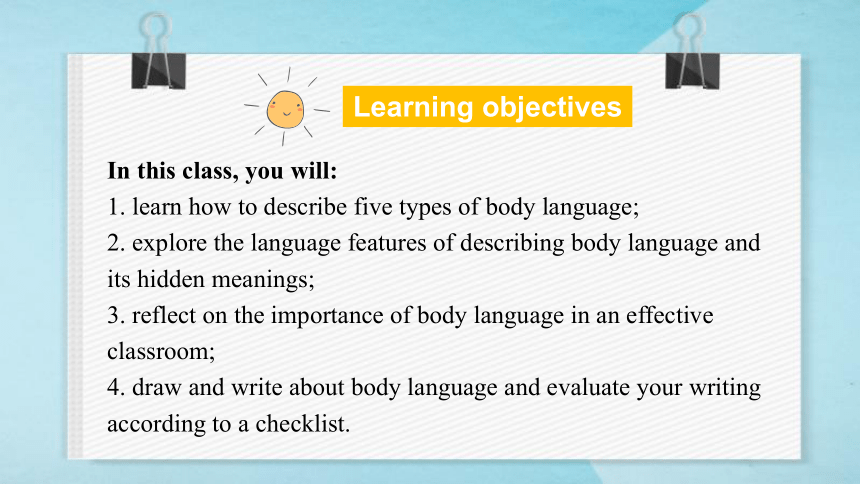
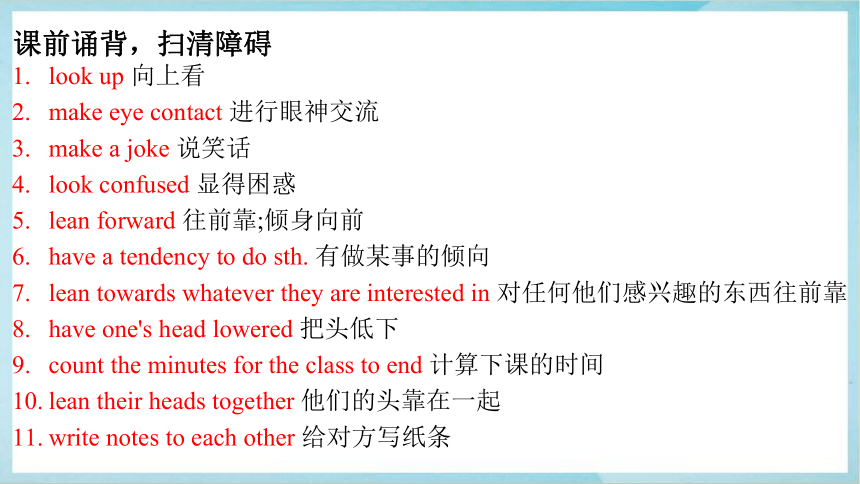
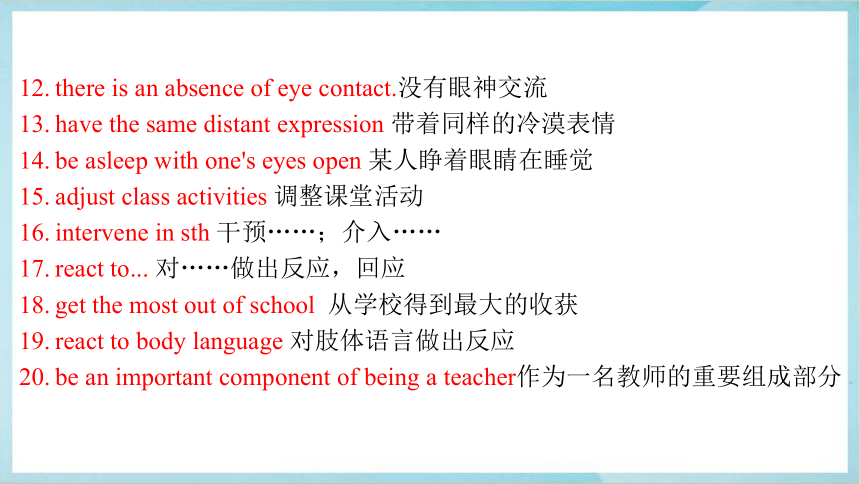
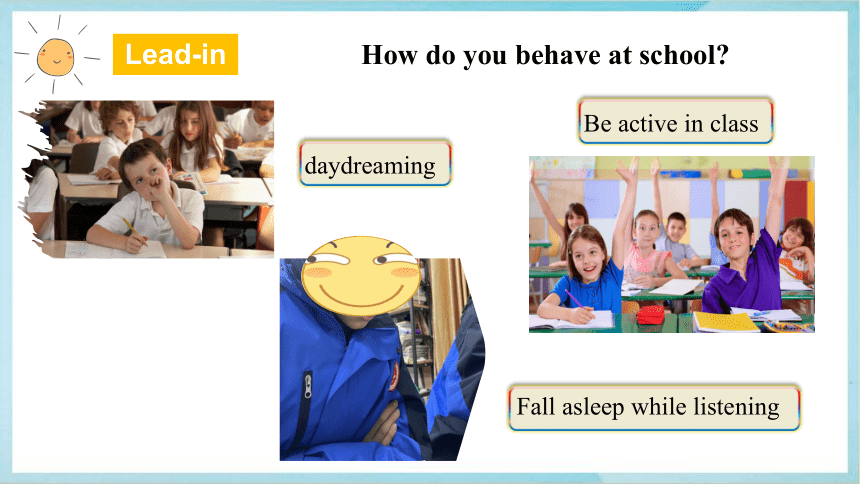
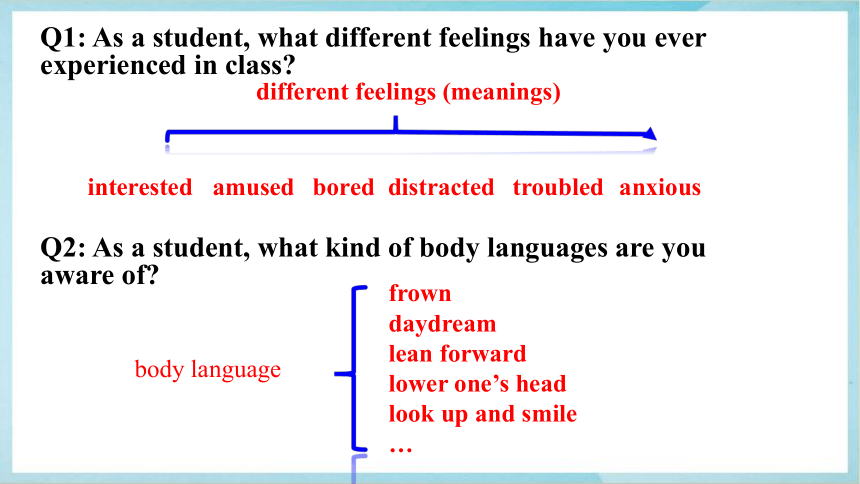
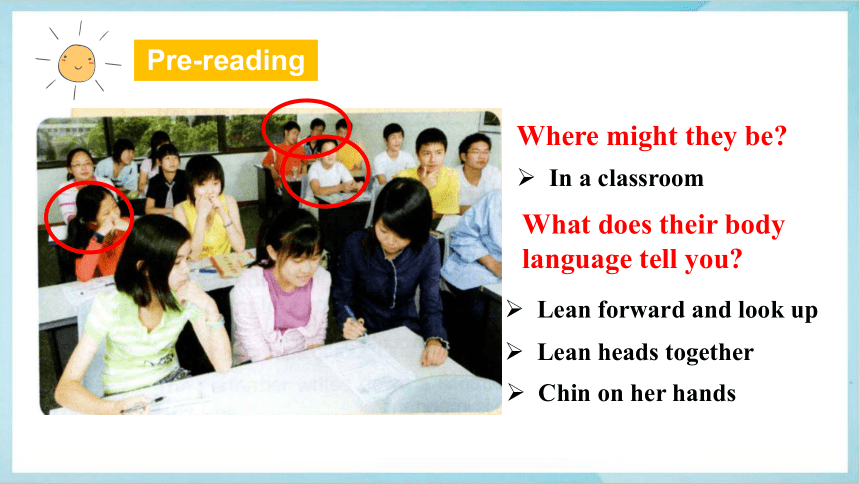
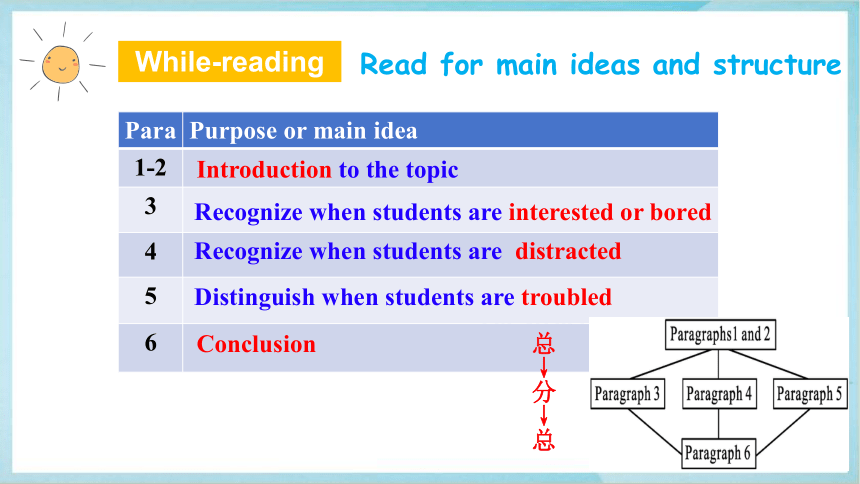
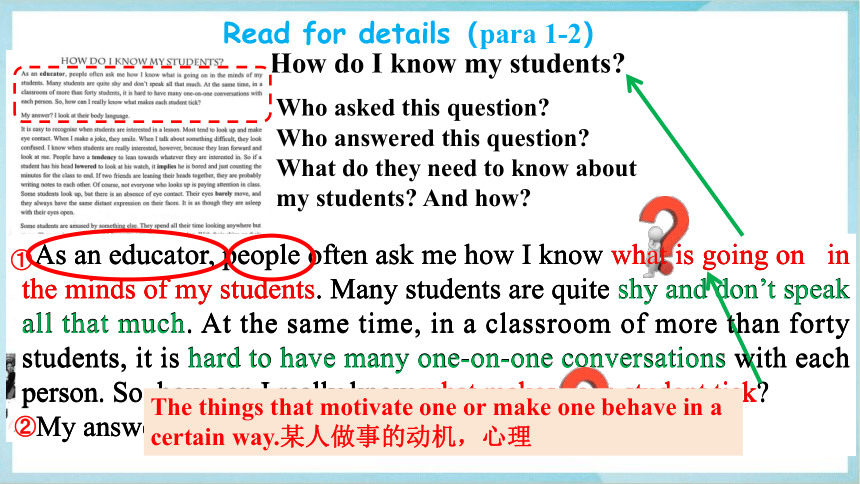
文档简介
(共27张PPT)
Unit 4 Body Language
Using Language 2
How do I know my students
In this class, you will:
1. learn how to describe five types of body language;
2. explore the language features of describing body language and its hidden meanings;
3. reflect on the importance of body language in an effective classroom;
4. draw and write about body language and evaluate your writing according to a checklist.
Learning objectives
look up 向上看
make eye contact 进行眼神交流
make a joke 说笑话
look confused 显得困惑
lean forward 往前靠;倾身向前 as though/if...
have a tendency to do sth. 有做某事的倾向
lean towards whatever they are interested in 对任何他们感兴趣的东西往前靠
have one's head lowered 把头低下
count the minutes for the class to end 计算下课的时间
lean their heads together 他们的头靠在一起
write notes to each other 给对方写纸条
课前诵背,扫清障碍
there is an absence of eye contact.没有眼神交流
have the same distant expression 带着同样的冷漠表情
be asleep with one's eyes open 某人睁着眼睛在睡觉
adjust class activities 调整课堂活动
intervene in sth 干预……;介入……
react to... 对……做出反应,回应
get the most out of school 从学校得到最大的收获
react to body language 对肢体语言做出反应
be an important component of being a teacher作为一名教师的重要组成部分
daydreaming
Be active in class
Fall asleep while listening
How do you behave at school
Lead-in
Q1: As a student, what different feelings have you ever experienced in class
Q2: As a student, what kind of body languages are you aware of
body language
frown
daydream
lean forward
lower one’s head
look up and smile
…
bored
amused
distracted
troubled
anxious
interested
different feelings (meanings)
Where might they be
What does their body
language tell you
Lean forward and look up
Lean heads together
Chin on her hands
In a classroom
Pre-reading
The structure:
Para Purpose or main idea
1-2
3
4
5
6
Introduction to the topic
Recognize when students are interested or bored
Recognize when students are distracted
Distinguish when students are troubled
Conclusion
总
↓
分
↓
总
While-reading
Read for main ideas and structure
How do I know my students
Who asked this question
Who answered this question
What do they need to know about
my students And how
As an educator, people often ask me how I know what is going on in the minds of my students. Many students are quite shy and don’t speak all that much. At the same time, in a classroom of more than forty students, it is hard to have many one-on-one conversations with each person. So, how can I really know what makes each student tick
My answer I look at their body language.
②
①
As an educator, people often ask me how I know what is going on in the minds of my students. Many students are quite shy and don’t speak all that much. At the same time, in a classroom of more than forty students, it is hard to have many one-on-one conversations with each person. So, how can I really know what makes each student tick
My answer I look at their body language.
As an educator, people often ask me how I know what is going on in the minds of my students. Many students are quite shy and don’t speak all that much. At the same time, in a classroom of more than forty students, it is hard to have many one-on-one conversations with each person. So, how can I really know what makes each student tick
My answer I look at their body language.
The things that motivate one or make one behave in a certain way.某人做事的动机,心理
Read for details(para 1-2)
⑤
③
④
Body language Meaning
… …
Read for details
单击此处添加标题
Match the body language with the meanings.
___ 1 Looking up and making eye contact ___ 2 Leaning over to look at one’s watch ___ 3 Two friends leaning heads together ___ 4 Leaning forward and looking at the teacher ___ 5 Looking up, but no eye contact, no expression ___ 6 Looking away ___ 7 Chin on hand, looking out the window ___ 8 Looking down, arms or legs crossed ___ 9 Frowning ___ 10 Hair not brushed, red eyes A very interested
B bored
C interested
D sad or worried
E distracted
F writing notes
G serious problems
H like they are asleep
I daydreaming
J angry, afraid, or experiencing anxiety
C
B
F
A
H
E
I
D
J
G
Read for details
Body language Meaning Reaction
Look up and make eye contact
Lean forward and look at…
Lower his head to look at…
Lean their heads together
Look up but eyes barely move
Smile
Look confused
Interested
Really interested
Bored
Look anywhere but at the teacher
Chins on hands, stare out of the
window or…
Amused by
something else
Distracted
Keep their interest
Adjust class
activities
Remind
Intervene
Expressions to show amusement:
They spend all their time looking anywhere but at me.
…some students’ favourite activity is daydreaming.
…they occupy themselves by staring out of the window or up at the ceiling.
Read for details(para3-4)
Body language Meaning Reaction
Look up and make eye contact
Lean forward and look at…
Lower his head to look at…
Lean their heads together
Look up but eyes barely move
Smile
Look Confused
Interested
Really interested
Bored
Look anywhere but at the teacher
Chins on hands, stare out of the window or…
Distracted
Keep their interest
Adjust class
activities
Intervene
Easy
It is easy to recognise when students are interested in a lesson.
While it is easy to perceive when students are interested, bored, or distracted, …
…it is sometimes much harder to distinguish when students are troubled.
Read for details(para3-4)
Body language Meaning Reaction
Arms crossed and legs closed
Wear a frown
Hide faces in hands
Not brush hair; eyes red
Angry, afraid or anxious
Sad or worried
Embarrassed or ashamed
Deep issues
Troubled
/Serious conflicts
Inquire and
assess
Talk
individually
Uncertain
Students who are angry, afraid, or experiencing anxiety may have their arms crossed…
How to show uncertainty:
Read for details(para 5)
Students who are angry, afraid, or experiencing anxiety may have their arms crossed…
How to show uncertainty:
They may also hide their faces in their hands like they are embarrassed or ashamed.
It could be that she is having serious conflicts with other students or at home.
…, then I can infer that there are deeper issues at work.
Students who are sad or worried will nearly always wear a frown.
Read for language(para 5)
To keep their interest
To adjust class activities
To intervene…
To talk individually
How to react
To look at body language
To help every student to learn
To get the most out of school
An important component of being a teacher
Read for details(para 6)
Look at the following photos. In groups, discuss what these people are doing and what their body language is telling you.
① What are these people doing
② What is their body language telling us
Discussion
Many students are raising their hand to speak.
Perhaps the teacher has just asked the class a question.
The boy is raising or shaking his fist with a smile to show his determination or confidence to achieve a goal or task.
The boy is leaning over and whispering something interesting to the girl in her ear.
The girl is listening to it with so much enjoyment as to cover her mouth with both her hands to avoid giving a loud laugh.
Draw someone you know. Show his/her body language in your drawing.
如何描述
肢体语言
描述肢体语言,说明肢体语言的意义的文章属于说明文。用灵活的语言对图片里的肢体语言进行生动的描写。
注意:
内容积极向上,
语意通顺,
结构连贯完整,
词数80左右。
明确体裁话题
确定时态人称
布局文章架构
列出核心要点
Write an introduction of Body language.
首段:简要描述这种肢体语言。
中段:用1-2个相关事例进行具体描述。
尾段:适当总结。
描述某些肢体语言。
文体:说明文
一般现在时、
第三人称
1.从动作、神态方面描述肢体
语言的具体特征。
2.描写这种肢体语言出现的场
合和含义等。
This is my friend, Allen. He is bending over a piece of paper with a pencil in his hand, drawing. His other hand holds an eraser near the paper, because he wants to be able to use it as soon as he needs it without wasting time. Allen is a very serious artist, which you can tell from the intense look on his face.
When he is drawing, he tends to block out everything else in the world. Often,when other people call out his name, he does not even hear them because he is lost in his art.
Write a passage to describe the body language of the person in your drawing, and explain what his/her body language tells us.
Is the person properly identified
Is the description clear
Does the writer give his/her
impressions of the feelings and
personality of the person in the
drawing, and also explain why he/she
has these impressions
Does the writer use correct grammar,
punctuation, and spelling
Use the checklist to help you review your partner s draft.
Take your draft back and revise it.
Share your drawing and description with the rest of the class.
Unit 4 Body Language
Using Language 2
How do I know my students
In this class, you will:
1. learn how to describe five types of body language;
2. explore the language features of describing body language and its hidden meanings;
3. reflect on the importance of body language in an effective classroom;
4. draw and write about body language and evaluate your writing according to a checklist.
Learning objectives
look up 向上看
make eye contact 进行眼神交流
make a joke 说笑话
look confused 显得困惑
lean forward 往前靠;倾身向前 as though/if...
have a tendency to do sth. 有做某事的倾向
lean towards whatever they are interested in 对任何他们感兴趣的东西往前靠
have one's head lowered 把头低下
count the minutes for the class to end 计算下课的时间
lean their heads together 他们的头靠在一起
write notes to each other 给对方写纸条
课前诵背,扫清障碍
there is an absence of eye contact.没有眼神交流
have the same distant expression 带着同样的冷漠表情
be asleep with one's eyes open 某人睁着眼睛在睡觉
adjust class activities 调整课堂活动
intervene in sth 干预……;介入……
react to... 对……做出反应,回应
get the most out of school 从学校得到最大的收获
react to body language 对肢体语言做出反应
be an important component of being a teacher作为一名教师的重要组成部分
daydreaming
Be active in class
Fall asleep while listening
How do you behave at school
Lead-in
Q1: As a student, what different feelings have you ever experienced in class
Q2: As a student, what kind of body languages are you aware of
body language
frown
daydream
lean forward
lower one’s head
look up and smile
…
bored
amused
distracted
troubled
anxious
interested
different feelings (meanings)
Where might they be
What does their body
language tell you
Lean forward and look up
Lean heads together
Chin on her hands
In a classroom
Pre-reading
The structure:
Para Purpose or main idea
1-2
3
4
5
6
Introduction to the topic
Recognize when students are interested or bored
Recognize when students are distracted
Distinguish when students are troubled
Conclusion
总
↓
分
↓
总
While-reading
Read for main ideas and structure
How do I know my students
Who asked this question
Who answered this question
What do they need to know about
my students And how
As an educator, people often ask me how I know what is going on in the minds of my students. Many students are quite shy and don’t speak all that much. At the same time, in a classroom of more than forty students, it is hard to have many one-on-one conversations with each person. So, how can I really know what makes each student tick
My answer I look at their body language.
②
①
As an educator, people often ask me how I know what is going on in the minds of my students. Many students are quite shy and don’t speak all that much. At the same time, in a classroom of more than forty students, it is hard to have many one-on-one conversations with each person. So, how can I really know what makes each student tick
My answer I look at their body language.
As an educator, people often ask me how I know what is going on in the minds of my students. Many students are quite shy and don’t speak all that much. At the same time, in a classroom of more than forty students, it is hard to have many one-on-one conversations with each person. So, how can I really know what makes each student tick
My answer I look at their body language.
The things that motivate one or make one behave in a certain way.某人做事的动机,心理
Read for details(para 1-2)
⑤
③
④
Body language Meaning
… …
Read for details
单击此处添加标题
Match the body language with the meanings.
___ 1 Looking up and making eye contact ___ 2 Leaning over to look at one’s watch ___ 3 Two friends leaning heads together ___ 4 Leaning forward and looking at the teacher ___ 5 Looking up, but no eye contact, no expression ___ 6 Looking away ___ 7 Chin on hand, looking out the window ___ 8 Looking down, arms or legs crossed ___ 9 Frowning ___ 10 Hair not brushed, red eyes A very interested
B bored
C interested
D sad or worried
E distracted
F writing notes
G serious problems
H like they are asleep
I daydreaming
J angry, afraid, or experiencing anxiety
C
B
F
A
H
E
I
D
J
G
Read for details
Body language Meaning Reaction
Look up and make eye contact
Lean forward and look at…
Lower his head to look at…
Lean their heads together
Look up but eyes barely move
Smile
Look confused
Interested
Really interested
Bored
Look anywhere but at the teacher
Chins on hands, stare out of the
window or…
Amused by
something else
Distracted
Keep their interest
Adjust class
activities
Remind
Intervene
Expressions to show amusement:
They spend all their time looking anywhere but at me.
…some students’ favourite activity is daydreaming.
…they occupy themselves by staring out of the window or up at the ceiling.
Read for details(para3-4)
Body language Meaning Reaction
Look up and make eye contact
Lean forward and look at…
Lower his head to look at…
Lean their heads together
Look up but eyes barely move
Smile
Look Confused
Interested
Really interested
Bored
Look anywhere but at the teacher
Chins on hands, stare out of the window or…
Distracted
Keep their interest
Adjust class
activities
Intervene
Easy
It is easy to recognise when students are interested in a lesson.
While it is easy to perceive when students are interested, bored, or distracted, …
…it is sometimes much harder to distinguish when students are troubled.
Read for details(para3-4)
Body language Meaning Reaction
Arms crossed and legs closed
Wear a frown
Hide faces in hands
Not brush hair; eyes red
Angry, afraid or anxious
Sad or worried
Embarrassed or ashamed
Deep issues
Troubled
/Serious conflicts
Inquire and
assess
Talk
individually
Uncertain
Students who are angry, afraid, or experiencing anxiety may have their arms crossed…
How to show uncertainty:
Read for details(para 5)
Students who are angry, afraid, or experiencing anxiety may have their arms crossed…
How to show uncertainty:
They may also hide their faces in their hands like they are embarrassed or ashamed.
It could be that she is having serious conflicts with other students or at home.
…, then I can infer that there are deeper issues at work.
Students who are sad or worried will nearly always wear a frown.
Read for language(para 5)
To keep their interest
To adjust class activities
To intervene…
To talk individually
How to react
To look at body language
To help every student to learn
To get the most out of school
An important component of being a teacher
Read for details(para 6)
Look at the following photos. In groups, discuss what these people are doing and what their body language is telling you.
① What are these people doing
② What is their body language telling us
Discussion
Many students are raising their hand to speak.
Perhaps the teacher has just asked the class a question.
The boy is raising or shaking his fist with a smile to show his determination or confidence to achieve a goal or task.
The boy is leaning over and whispering something interesting to the girl in her ear.
The girl is listening to it with so much enjoyment as to cover her mouth with both her hands to avoid giving a loud laugh.
Draw someone you know. Show his/her body language in your drawing.
如何描述
肢体语言
描述肢体语言,说明肢体语言的意义的文章属于说明文。用灵活的语言对图片里的肢体语言进行生动的描写。
注意:
内容积极向上,
语意通顺,
结构连贯完整,
词数80左右。
明确体裁话题
确定时态人称
布局文章架构
列出核心要点
Write an introduction of Body language.
首段:简要描述这种肢体语言。
中段:用1-2个相关事例进行具体描述。
尾段:适当总结。
描述某些肢体语言。
文体:说明文
一般现在时、
第三人称
1.从动作、神态方面描述肢体
语言的具体特征。
2.描写这种肢体语言出现的场
合和含义等。
This is my friend, Allen. He is bending over a piece of paper with a pencil in his hand, drawing. His other hand holds an eraser near the paper, because he wants to be able to use it as soon as he needs it without wasting time. Allen is a very serious artist, which you can tell from the intense look on his face.
When he is drawing, he tends to block out everything else in the world. Often,when other people call out his name, he does not even hear them because he is lost in his art.
Write a passage to describe the body language of the person in your drawing, and explain what his/her body language tells us.
Is the person properly identified
Is the description clear
Does the writer give his/her
impressions of the feelings and
personality of the person in the
drawing, and also explain why he/she
has these impressions
Does the writer use correct grammar,
punctuation, and spelling
Use the checklist to help you review your partner s draft.
Take your draft back and revise it.
Share your drawing and description with the rest of the class.
